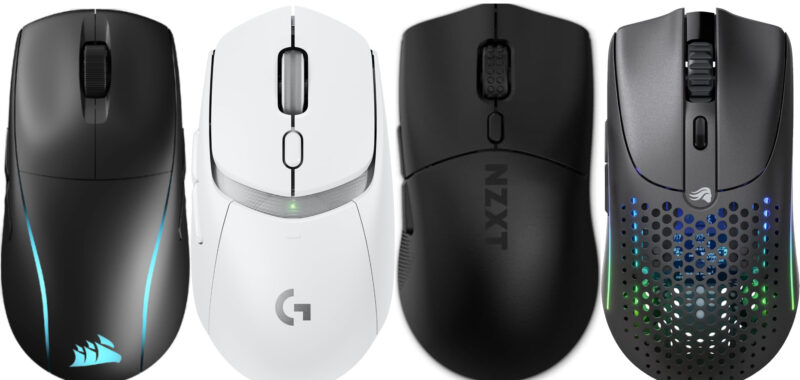We may earn revenue from the products available on this page and participate in affiliate programs. Learn more ›
The gaming mouse you choose can profoundly impact your gaming experience. A good gaming mouse has three core qualities: they’re impeccably accurate, are responsive enough that your actions feel instantaneous, and feel good to use—from the comfort and ergonomics of their shape to the crisp click of their buttons. But, just like when shopping for any computer peripherals, the market for these mice is inundated with choices, some much better than others. Don’t let marketing terms and misleading Amazon reviews steer you wrong. We’ve done the research to help you find the mouse for your favorite games—like our best overall, the Razer Viper V3 Pro Wireless—and have the go-to tips to help you focus on what matters most in a gaming mouse. TL;DR, these are the best wireless gaming mice (plus two wired ones).
How we chose the best wireless gaming mice
I’ve been writing online since 2008. Before I was a tech writer, my forte was video games. I covered the wide world of PC and console gaming for five years before incorporating tech coverage into the mix. In 2015, I began covering tech full-time with a special emphasis on PC gaming peripherals. I’ve covered gaming mice (and pretty much every other kind of PC gaming tech) for IGN, Tom’s Hardware, Reviewed, Popular Mechanics, PC Perspective, MMORPG, and, of course, Popular Science. I know exactly what to consider when shopping for a gaming mouse and what it takes to find the best pick for different types of users.
For this round-up, I began by considering the many mice I’ve tested over the last several years. Of the nine picks I settled on, I’ve extensively tested seven of them and used the predecessor of my portable pick as my personal on-the-go mouse since its release. I compared my original list of around 15 mice to critical reviews and consumer reviews on sites such as Amazon and Best Buy. Using this range of first-hand impressions, critical hot takes, consumer feedback, and deep consideration of each choice’s specs, design, and features, I settled on a final list of the best cordless mouse you can buy for every use case. This list consists of many newer picks and several established choices that remain top-tier.
The best wireless gaming mice: Reviews & Recommendations
While I still love my wired headphones, I’ve come to really appreciate the convenience of wireless mechanical keyboards and equally untethered mice. With certain guidelines in mind (see our “What to consider” section below), you’re ready to do a deep dive to find the best mouse for your needs. But we’ve got you covered if you’d rather see the best choices immediately. The following are the best gaming mice of 2024.
Best overall: Razer Viper V3 Pro Wireless

Chris Coke
See It
Why it made the cut: This high-performance mouse blends comfort, accuracy, responsiveness, and advanced features to be the best all-around pick.
Specs
- Price: $159.99
- Button count: 6
- Sensor/DPI: Focus Pro Optical Sensor Gen-2, 35K DPI
- Polling rate: 8,000Hz
- Weight: 54g
- Connectivity: Razer HyperSpeed
- Battery life: Up to 95 hours
- Software: Razer Synapse
Pros
- Extremely responsive
- Angle adjustment, dynamic sensitivity, and other advanced features
- Refined shape for superior accuracy
Cons
- Requires software to take advantage of all features
The Razer Viper V3 Pro is the latest version of Razer’s popular FPS flagship. This mouse brings with it a top-of-the-line sensor, refined shape, rapid 8kHz polling, and reliable HyperSpeed wireless connectivity, all in an ultralight shell. If that weren’t enough, it features the company’s highest-performance optical switches that are rated for up to 90 million clicks each!
Every mouse in this round-up offers great performance, but what gives the Viper the nod in my mind is its combination of unique advanced features, accessible within the Razer Synapse software. For example, it’s the only mouse I’ve encountered where you can compensate if you hold it at an angle—which many people do without even realizing it—to improve your accuracy in a single click. You can enable dynamic sensitivity that adjusts your DPI based on how fast the mouse is moving. It even has a feature to match the exact DPI of your previous mouse by plugging it in first and letting Synapse get a read of it. Pros now: 800 DPI from one brand may not be an exact match for another. This setting allows you to avoid the tedious process of dialing in your sensitivity all over again.
The Viper V3 Pro is an example of where everything comes together right. It isn’t the best choice for games that require lots of buttons or if you want to avoid companion software, but it’s a stellar pick with impressive performance, ergonomics, and features.
Best for FPS: Logitech G Pro X Superlight 2
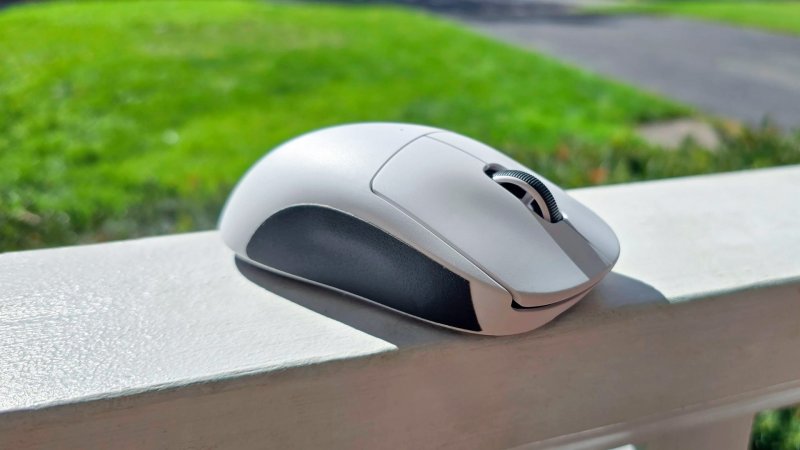
Chris Coke
See It
Why it made the cut: Doubling as the Best Splurge, the Superlight 2 is the choice of more esports athletes than any other mouse.
Specs
- Price: $149.99
- Button count: 6
- Sensor/DPI: HERO 2, 44K DPI
- Polling rate: 8,000Hz
- Weight: 60g
- Connectivity: Lightspeed Wireless, wired
- Battery life: Up to 90 hours
- Software: Logitech G Hub
Pros
- Classic, comfortable shape that’s easy to adapt to
- Supports different grip styles
- High polling rate, high accuracy
Cons
- Not very different from original G Pro X Superlight
- No Bluetooth support
The Logitech G Pro X Superlight 2 is the successor to one of the most popular gaming mice in all of professional esports. It’s no wonder. The modern G Pro mouse has undergone multiple iterations since its launch in 2016, and the Superlight 2 represents years of refinement, both in shape, the quality of its sensor, and the reliability of its buttons. Perhaps as a result of its incredible popularity in the pro circuit, it pulls double-duty as the best splurge thanks to its $150 asking price—but it’s worth it for competitive esports players.
The Superlight 2 features Logitech’s highest-performance optical sensor to date. Dubbed HERO 2, it’s able to reach an impressive 44,000 DPI. The company prides itself on the accuracy of its tracking, so whether you’re playing at low sensitivities and using big arm sweeps or high DPI with low in-game sensitivity, it offers pixel-perfect tracking. Its clicks are just as high-performance thanks to its LightForce hybrid optical-mechanical switches. These offer the impressive tactility of mechanical switches with the improved durability and speed of optical. Logitech doesn’t share any expected lifespan, but optical switches usually range from 70 million to 100 million clicks.
The biggest knock this mouse has received is that it’s not all that different than its predecessor, the standard Logitech G Pro X Superlight. It features a new sensor, 8K polling, and an additional 20 hours of battery life, but the look, shape, and feel are exactly the same—and Logitech still hasn’t added Bluetooth support. On the plus side, if you’re looking for a very similar experience for less, the original will save you $50-60, depending on the sale.
Best for MOBAs and MMOs: Corsair Scimitar Elite RGB Wireless

Crosair
See It
Why it made the cut: This many-buttoned mouse is perfect for games that require lots of programmable buttons, and it doesn’t trade functionality for heaviness.
Specs
- Price: $99.99
- Button count: 16
- Sensor/DPI: Corsair Marksman Optical Sensor, 26K
- Polling rate: 2,000Hz
- Weight: 114g
- Connectivity: Bluetooth, SlipStream Wireless, wired
- Battery Life: Up to 120 hours
- Software: Corsair iCUE
Pros
- Tons of buttons
- In-depth programmability via iCUE
- Movable thumb grid for easier access and comfort
Cons
As a longtime MMORPG player, I can tell you from first-hand experience how helpful thumb buttons can be on a gaming mouse. When you’re juggling dozens of abilities, items, and consumables, six buttons just aren’t enough—especially when you also need to stay moving to avoid a nasty attack from a raid boss. The Corsair Scimitar Elite Wireless stands ready to deliver with a total of 16 programmable inputs, a low weight for utility outside of MMOs and MOBAs, impressive RGB, and long-lasting battery life.
Like a number of other “MMO mice,” the Scimitar Elite utilizes a thumb cluster of twelve programmable buttons. These can be anything from basic numbers, coinciding with your skill bars in World of Warcraft, to full-fledged macros with everything in between. The level of programmability is impressive, but what makes this my top pick is that the thumb cluster is slideable for easier access. On every other MMO mouse, accessing the full array of buttons is challenging, but not so here, which makes it a better fit (literally) for any gamer.
In addition, it’s also just a killer gaming mouse. It uses a high-quality Marksman sensor capable of reaching a maximum DPI of 26,000. It has a 2,000Hz polling rate, which is more than enough for MMOs, MOBAs, and most other games, and uses optical key switches under its buttons rated for 100 million clicks each. You trade some weight for that thumb cluster, but it’s definitely worth it for all the Scimitar Elite Wireless brings to the table.
Best ultralight: Asus ROG Harpe
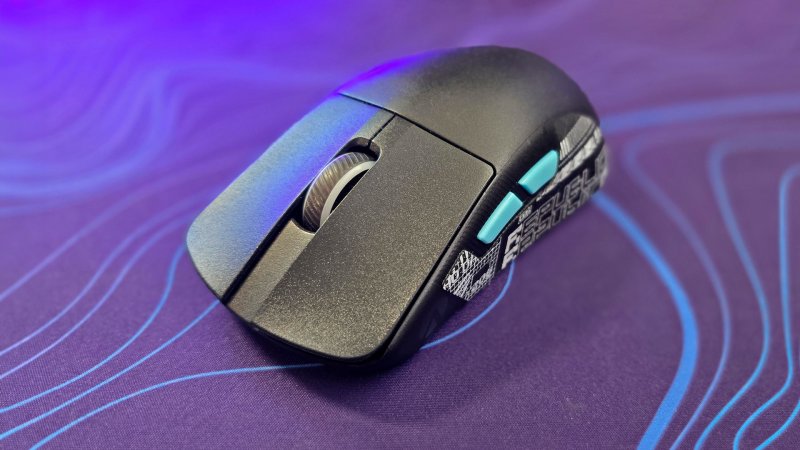
Chris Coke
See It
Why it made the cut: At 54 grams, the Harpe Ace almost feels like an extension of your arm.
Specs
- Price: $89.99
- Button count: 6
- Sensor/DPI: ROG AimPoint Pro Optical Sensor, 36K
- Polling rate: 1,000Hz (8,000Hz with booster)
- Weight: 54g
- Connectivity: Bluetooth 5.1, ROG SpeedNova, wired
- Battery life: Up to 90 hours
- Software: Asus Armoury Crate Gear
Pros
- Exceptionally small and light
- Great shape for stable aiming
- Easily configurable
Cons
- Polling rate booster isn’t included
The Asus ROG Harpe Ace was one of my favorite mice of last year. It’s positively svelte, weighing in at only 54 grams, but doesn’t resort to a honeycomb shell to achieve that weight. In fact, it’s remarkably solid and doesn’t offer any noticeable flex or creak, even when you’re trying to make it do exactly those things. It’s supremely accurate, ridiculously fast, and is versatile enough for everything from essays to victory royales.
The Harpe Ace was designed with competitive play in mind. In fact, Asus partnered with AimLabs on its design, integrating it with the company’s dedicated aim training software. It features an excellent 36K AimPoint Pro optical sensor to keep your shots on lock and high-quality mechanical switches rated for 70 million clicks each. Most importantly, its shape is low enough to cater to the all-popular claw and fingertip grip styles in first-person shooters, but it’s also long enough and wide enough to support your hand without forcing you to drag your fingers and slow down its speed. Paired with a great hard mouse pad, the Harpe Ace is fast.
Unlike many of its key competitors, it only has a 1,000Hz polling rate. While fine for most gamers, it’s still not as fast as some of the competition at this price. It can be, but only if you buy a separate polling rate booster, which can be hard to find in stock (and really should have been included anyway). Still, it’s a highly accurate mouse that’s perfect for fine-tuning your aim and leveling up your skill.
Best left-handed: Corsair M73 Wireless

Corsair
See It
Why it made the cut: With swappable side buttons, this ambidextrous mouse can be used by righties or lefties without sacrifices.
Specs
- Price: $129
- Button count: Up to eight
- Sensor/DPI: Corsair Marksman Optical Sensor, 26K
- Polling rate: 2,000Hz
- Weight: 89g
- Connectivity: Bluetooth, SlipStream Wireless, wired
- Battery life: Up to 210 hours
- Software: Corsair iCUE
Pros
- Swappable side buttons
- High-speed wireless
- Sleek with stylish RGB
Cons
Left-handed gamers are too often left out in the cold for PC gaming peripherals. Even on this list, there are “ambidextrous” mice that are clearly designed for right-handed gamers. If you’re a lefty looking for a great mouse that’s actually left-handed, look no further than the MW75 Wireless from Corsair.
The MW75 earns our top pick because of its excellent swappable side-button system, on top of just being a great gaming mouse in general. Included in the box are side buttons for the left and right side, allowing you to have proper thumb buttons no matter which hand you prefer. For the opposite side, there are flush plates that blend into the rest of the frame. Swapping them out is easy, thanks to their magnetic connections, but once they’re in place, they’re rock solid and won’t detach without using a fingernail to pry them off.
At 89 grams, it’s not the lightest gaming mouse. Lefties are still limited when it comes to ultralight gaming mice, but this one is certainly not heavy. It features excellent SlipStream wireless connectivity that offers up to a 2,000Hz polling rate and 0.5ms of input latency. Because it’s Corsair, it’s also totally remappable with commands, shortcuts, and macros, and has customizable RGB as a cherry on top. It’s a great pick, and unlike those other mice, it’s actually ambidextrous.
Best ergonomic: Logitech G Pro X Superlight 2 DEX
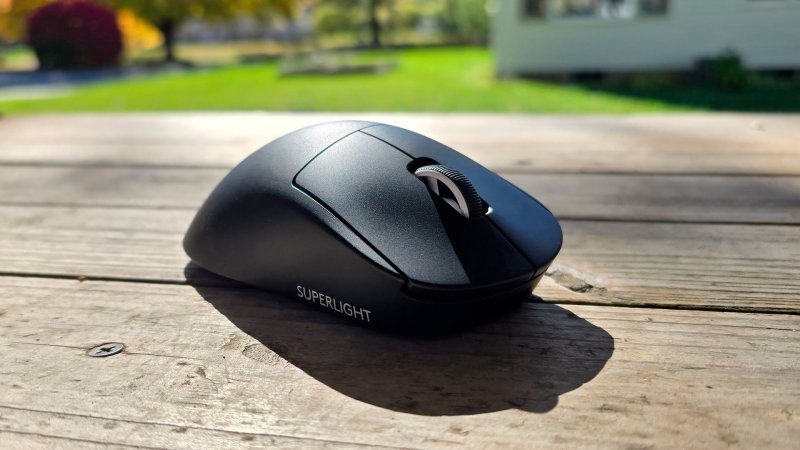
Chris Coke
See It
Why it made the cut: All the goodness of the Logitech G Pro X Superlight 2 with a more ergonomic shape.
Specs
- Price: $159.99
- Button count: 6
- Sensor/DPI: HERO 2 Optical Sensor, 44K
- Polling rate: 8,000Hz
- Weight: 60g
- Connectivity: Lightspeed Wireless, Wired
- Battery life: Up to 95 hours
- Software: Logitech G Hub
Pros
- Bigger hump supports more grip styles
- Ergonomic tilt to prevent wrist strain
- Excellent buttons and sensor
Cons
If you’re looking for an ergonomic mouse that doesn’t sacrifice gaming features or performance to get there, the Logitech G Pro X Superlight 2 Dex is the natural choice. Its name might be a bit of a mouthful, but it’s easy on the hands and offers the same set of features that make the standard Superlight 2 our top pick for esports.
The biggest difference between the two mice is their shape. The Dex features a taller, more angular design, not unlike the Logitech MX Master 3S (minus the thumb ledge that makes that one our best mouse for Macs). This allows your hand to rest in a more natural position, reducing strain over long gaming sessions. It also finally opens the G Pro X Superlight experience to palm grip users thanks to its larger size. In my testing, I found it to be significantly more comfortable without impacting my aim as I got used to it—and that’s saying something because the Superlight 2 was already an easy mouse to enjoy.
All of the other specs and features remain the same, except one: battery life. This new model is able to last an additional five hours over the original (95 hours total). It still has the same excellent HERO sensor with 44,000 maximum DPI and excellent LightForce switches. Its differences simply make it more accessible to a wider range of gamers, and that’s a great thing.
Best portable: Logitech G309 Lightspeed

Logitech
See It
Why it made the cut: Small in size, light in weight, and with battery life for days, this is an excellent choice for gamers on the go.
Specs
- Price: $79
- Button count: 6
- Sensor/DPI: HERO 25K Optical Sensor, 25K
- Polling rate: 1,000Hz
- Weight: 68g with PowerPlay, 86g with AA battery
- Connectivity: Bluetooth, Lightspeed Wireless
- Battery life: Up to 600+ hours
- Software: Logitech G Hub
Pros
- Fantastic battery life
- Small and easy to carry in a bag
- Bluetooth and 2.4GHz connectivity
Cons
- Cannot be used wired
- Requires AA battery or proprietary charging mat
For the last six years, the Logitech G305 has been my go-to travel mouse and one I recommend to anyone who will listen. That changed this year with the introduction of the Logitech G309 Lightspeed. This new version carries through the same small, low profile, and oh-so-portable design as the original while upgrading just about every aspect of its performance.
If you’re gaming on the go, you need a mouse with great battery life that doesn’t take up much space in your bag but still offers top-tier performance wherever you aim to game. That’s exactly what the Logitech G309 Lightspeed offers. At 89 grams and offering up to 300 hours of battery life with its gaming-grade Lightspeed wireless (and a whopping 600 hours over Bluetooth), you can rest easy knowing that a dead battery won’t keep you from a clutch match. If you do run low, all it takes is a single AA battery to get back in the action. Or, if you plan to use it at home, you can ditch the battery entirely and use Logitech’s PowerPlay charging mat for completely wireless, battery-free gameplay.
The upgrades on this model are definitely worth investing in for a portable gaming mouse. It uses Logitech’s HERO 25K optical sensor, which is renowned for its excellent tracking, Lightspeed switches instead of mechanical like the G305, and now features Bluetooth, while the previous version was Lightspeed only. Using an AA battery does add a bit of weight, and there’s no option for USB if you don’t have a battery, but it’s a worthwhile trade-off for what you’re getting.
Best value: Glorious Model O 2 Wireless
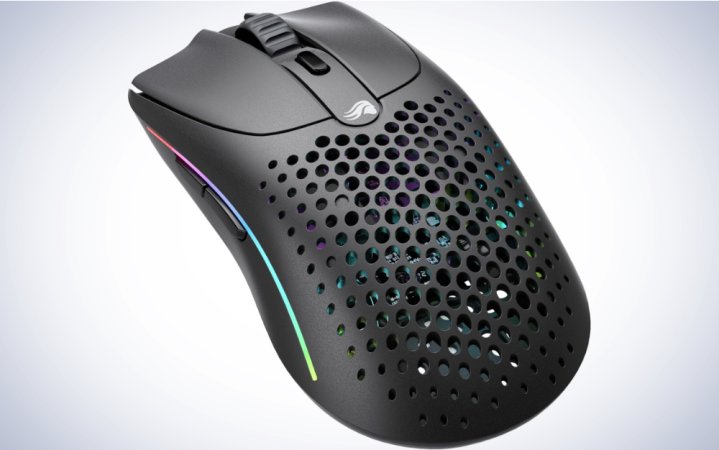
Glorious
See It
Why it made the cut: Affordably priced, high performance, and featuring an excellent paracord cable, the Model O 2 is a top-tier pick for reassuringly wired gaming.
Specs
- Price: $69.99
- Button count: 6
- Sensor/DPI: BAMF 2.0 Optical Sensor, 26K
- Polling rate: 1,000Hz
- Weight: 68g
- Battery Life: Up to 210 hours
- Software: Glorious Core
Pros
- High-performance sensor
- Great RGB illumination
- Ergonomic version available
Cons
- Honeycomb design risks dust build-up
Many of the best wireless gaming mice are priced well over $100, which is why the Glorious Model O 2 wins our accolade for the best value. It blends great ergonomics, precise tracking, and lite weight with a budget-friendly price. It also looks pretty cool, thanks to attractive RGB backlighting both inside and outside the mouse.
The Model O 2 Wireless is the sequel to the original Model O Wireless, the gaming mouse that helped put Glorious on the map. It features a symmetrical design (Glorious calls this ambidextrous, but its thumb buttons are designed for right-handed users) that’s quite similar to the Logitech G Pro in size but with a lower profile design and scoops on the left and right buttons to build up to support claw and fingertip grips in competitive shooters. It has high-quality switches rated for 80 million clicks each and a sensor that, while not the highest in DPI, is highly accurate and great for everything from competitive shooters to cozy games made for wiling away the evening.
Glorious achieves its 68-gram mass by dotting the palm rest with small holes. Despite this, it feels rigid and made to last. The company also uses it as an opportunity to add a bit of flair with RGB lighting that glows from its pores, as well as from two strips on either side that illuminate your mouse pad. At around $70, it’s a bargain for anyone who demands great ergonomics and performance on a budget.
Don’t mind wires and want to save even more? You’ll find additional value in the $45 Model O 2 Wired… or keep scrolling for our biggest bargain.
Best budget wired mouse: NZXT Lift 2 Symm
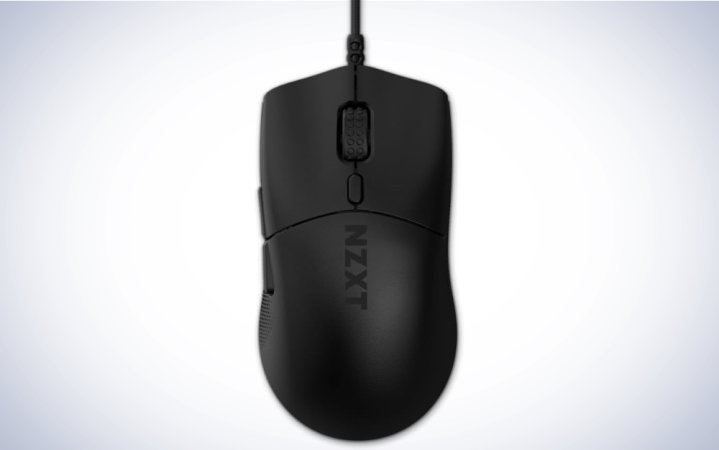
NZXT
See It
Why it made the cut: Don’t let its simplicity fool you. This wired mouse offers a lot for an exceptionally reasonable price.
Specs
- Price: $24.99
- Button count: 6
- Sensor/DPI: PixArt PMW3395
- Polling rate: 8,000Hz
- Weight: 59g
- Software: NZXT CAM
Pros
- Familiar ambidextrous shape
- Great sensor
- Solid top shell with a skeletonized bottom
Cons
You’re not going to get something wireless at this price point, but for high performance on a budget, the NZXT Lift 2 Symm offers a surprising bang for the buck. Thanks to a recent price cut, you can pick up this wired six-button mouse for less than $30. Critics like myself had some issues with the mouse when it first launched, but they were universally pretty small. At its current price, it’s hard to argue that it is anything other than a fantastic value.
The Lift 2 Symm is a mouse in the style of the Logitech G Pro in shape but sits slightly lower and lends itself well to a claw or fingertip grip. It weighs 59 grams, which makes it feel airy and light, and it has pure PTFE feet for a smooth glide on both hard and soft mouse pads. Unlike many ultralight mice, it features a solid top chassis to ward off dust build-up on its internals and instead has a skeletonized bottom. It’s unique and shows strong attention to community feedback: honeycomb tops are hit or miss among PC gamers. It also features a pliant paracord-wrapped cable that stays out of the way and makes the mouse feel wireless even though you’re tethered.
Its weight and cable are surprising enough at this price, but it also features a premium, competition-grade PixArt PMW3395 sensor and an 8,000Hz polling rate. Coming from such a well-known and established brand like NZXT, these are absolutely killer specs for the price, and they’re backed by solid build quality. The biggest nitpick I found with this mouse is that the clicks sound and feel a bit hollow compared to more expensive counterparts. But since they’re optical and rated for 100 million clicks each, you really don’t need to worry about their durability. Simply put, the NZXT Lift 2 Symm is the very definition of a bargain.
What to consider when buying one of the best wireless gaming mice
If you’re searching for a great gaming mouse, there are a number of important things to consider. These are the most important considerations to make before pulling the trigger on any purchase.
Shape, size, and grip type
Mice come in a wide range of shapes and sizes. Before settling on any particular mouse, you should begin by measuring the length and width of your hand to ensure you’re looking at a size that will be a comfortable and natural fit for your unique anatomy.

Logitech, Gravastar, and other mouse manufacturers (as well as the Occupational Health Clinics for Ontario Workers) offer guides to help you accurately measure your hand and provide recommendations for what size mouse you should consider. I have included the chart above for reference on whether you should be looking at small (mini), medium (standard), or large gaming mice.
The other element to consider is its shape. Typically, this refers to where and how prominent its contours are, as well as the shape of its left- and right-click buttons. Because it can be difficult to assess how different shapes will feel in your palm, manufacturers often describe their shapes by grip type.

The three main grip types are palm, claw, and fingertip grip. Claw and fingertip tend to be popular with fans of first-person shooters (FPS) and other fast-paced titles due to their more nimble posture, but there is no best choice. Look at how you hold your mouse when playing games now and compare it to the graphic above (courtesy of Redragon and its helpful guide).
Learning new grip types is possible, but it can be challenging if you’re doing so while also playing in competitive matches. I recommend choosing a mouse that matches your hand and the grip type you’re most comfortable with. If you do plan to learn a new grip, it can be helpful to do so in low-intensity games and outside of online matches.
Buttons and layout
How many buttons a mouse has and where they’re each positioned makes a big impact on its usability. If you’re a fan of games with many different skills or enjoy using macros, choosing a mouse with extra buttons under your thumb, like the Steelseries Aerox 9 Wireless or Razer Naga, can be helpful. If you’re a fan of shooters, a six-button mouse, like the Turtle Beach Burst II Air, will likely offer the best experience as it distills its inputs down to only the most necessary.
Extra buttons can be appealing, but note where they are and how likely you are to press them by accident. Also, note that mice with many buttons often rely on software that will need to be running in the background to utilize all of their features fully.
The final consideration with buttons is the switches they use inside of them. High-quality mechanical mouse switches typically come with a lifespan rating of 50 million clicks or more. Anything less, such as five million or 20 million clicks, can safely be considered middling or low quality.
Switches come in two forms: mechanical and optical. Mechanical switches use an electrical contact to trigger each click. They are the most common type of mouse button switch and have been used in some of the most popular mice of all time, such as the Logitech G502 and Razer DeathAdder. These switches deteriorate with extended use, and they can begin to exhibit double clicks when only one is intended. In contrast, optical switches use infrared light to trigger each click and don’t experience the same wear and tear. They are more durable over time and are generally considered to be of a higher quality than mechanical mouse switches.
Sensor and DPI
A mouse’s sensor is found on the bottom of the mouse and is a small lens that tracks its movement. Sensors come in either laser or optical types. For gaming, I recommend always sticking to an optical sensor. While laser sensor technology is newer and doesn’t struggle with accurately tracking on transparent surfaces like some optical sensors do, optical sensors are more consistent, accurate, and reliable across their DPI range on typical mousing surfaces. Many newer gaming mice also track on glass fine, so if you’d care to game on your glass coffee table, they’ll handle it just as well as a high-grade laser mouse.
Dots per inch (DPI) is a measurement that has gained a lot of attention in the world of gaming mice. It refers to the maximum sensitivity of a mouse and how quickly it can track. These days, it’s not uncommon to see gaming mice offer maximum DPI settings of 40,000 or more. Try using your mouse at such a high DPI, and you’ll quickly find out that it’s far too sensitive to use without dramatically lowering in-game mouse sensitivity to compensate. While some players swear by “high DPI, low sensitivity” gaming, the vast majority of esports pros game at 3,200 DPI or less.
So, why the high numbers? The industry seems to have gotten into the habit of one-upmanship, where higher DPIs indicate newer, higher-performance sensors rather than usable functionality for most gamers. High maximum DPIs often come with higher performance mice, but don’t get fooled into thinking that a higher DPI is automatically better. It likely won’t even matter.
Instead, it’s more important to look at the sensor being used and do a quick Google search for real user impressions. In general, anything from the PixArt 3360 upward, or named sensors like the Logitech HERO 2, are going to have excellent performance. Be wary of unnamed sensors, especially on very low-cost mice.
Wired or wireless?
Gaming mice can be either wired or wireless using Bluetooth or a version of 2.4GHz wireless (including all of the named wireless systems from major manufacturers: Logitech Lightspeed, Corsair SlipStream, Asus SpeedNova, etc.). So, you’re probably wondering if there are any disadvantages to using a wireless mouse. These days, wireless mice with a 2.4GHz connection typically perform just as well as a wired gaming mouse. You should avoid Bluetooth while gaming and leave it for productivity, however, as it’s a much slower form of wireless interface.
There are two things to keep in mind with wireless mice: battery type and battery life. Many wireless gaming mice feature rechargeable batteries. Depending on your choice, you’ll need to plug in anywhere from once or twice a week to once every few months. The best wireless gaming mice offer over 100 hours of gameplay—not simple “on” time.
Some gaming mice, such as the Logitech G309 Lightspeed, use AA or AAA batteries (we love rechargeables). While this can lead to many more hours of use, physical batteries can add significant weight and change how it feels to use.
It’s also important to note that mice with RGB LEDs can have dramatically lower battery life with RGB enabled. This is true of all wireless peripherals with RGB backlighting. Though the exact amount varies from mouse to mouse, and many manufacturers are not forthcoming about the difference RGB makes in battery life, plan on uptime to be cut at least in half with backlighting on full brightness.
Weight
The final consideration that many PC gamers consider fundamental is how much the mouse weighs. Only a handful of years ago, it was common to see mice weigh upwards of 100 grams and, as with the Logitech G502, sometimes even came with extra weights to make them heavier! Today, things have swung in the other direction, with mouse manufacturers touting how lightweight their mice are, even going as far as skeletonizing their exteriors to shave off extra grams of weight.
How heavy you want your mouse to feel is entirely subjective. But, as Corsair explains in this blog post, a lightweight mouse is probably a good idea if you’re a fan of first-person shooters. In shooters, many gamers find lower DPI settings to improve their accuracy. Low sensitivity settings require bigger movements of your hand and arm. In that case, a lighter mouse can enhance your accuracy by making those movements easier. On the other hand, many gamers, especially those who grew up with heavier mice, find light mice off-putting.
Ultimately, which weight is “best” is entirely a matter of personal preference.
FAQs
Yes. While it’s true that most mice will perform the basic duties of controlling the pointer, gaming mice feature higher specs, features, and shapes that cater to gaming performance. You may not notice much of a difference for slower-paced games, like card battlers, but for first-person shooters, RPGs, and other genres where you need to rely on fast and accurate clicks, a dedicated gaming mouse is the best choice.
While most gamers don’t need 8,000Hz polling, it’s certainly a nice feature to have. Because a mouse’s polling rate is how often it reports its position back to your PC, higher polling rates can translate into lower input latency. But whether or not you’ll notice the difference will depend on how sensitive you are. If you’re not aspiring to esports stardom or looking to raise the ceiling on your FPS play, you’ll most likely be fine with a mouse that reports at 1,000Hz or higher.
Wireless gaming mice typically connect using 2.4GHz wireless and a USB dongle. These dongles most often offer a 1,000Hz polling rate (1ms of input lag), equivalent to many wired gaming mice. Anything at this speed or higher is fast enough to eliminate noticeable lag. However, it’s important to check how a gaming mouse connects because anything less would be below the current baseline for responsiveness in games. A mouse that only connects using Bluetooth will be limited to 125Hz or 8ms of delay, resulting in noticeable lag.
So, you’re wondering whether you should buy a light or heavy mouse. Well, the optimal weight for a gaming mouse is subjective, but lightweight mice have indeed become one of the biggest trends in PC gaming peripherals over the last several years. With practice, lightweight mice can begin to feel like an extension of your arm, allowing you to move and react without thinking about the mouse in between your hand and the game. However, some people find lightweight mice to feel too sensitive or even cheap, so there is no one-size-fits-all.
Final thoughts on the best wireless gaming mice
Your gaming mouse can make or break your performance in an online match. While not a replacement for skill, the best gaming mice feel good to use, respond instantly and accurately, and ultimately get out of the way so you can let muscle memory take over. Armed with the knowledge of how to choose the best mouse for your needs and the go-to recommendations of the year, you’re ready to close the skill gap and meet your enemies head-on.

